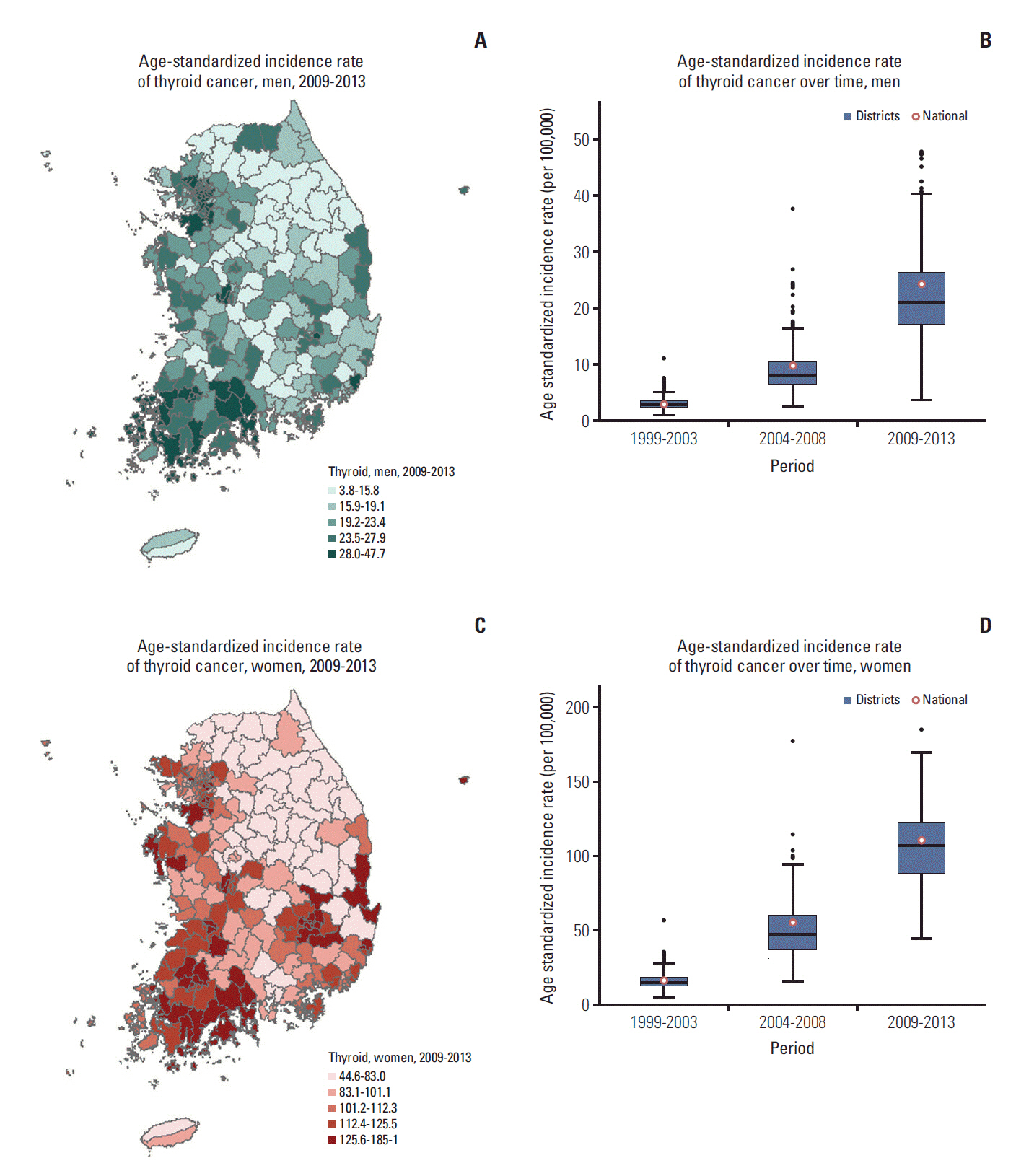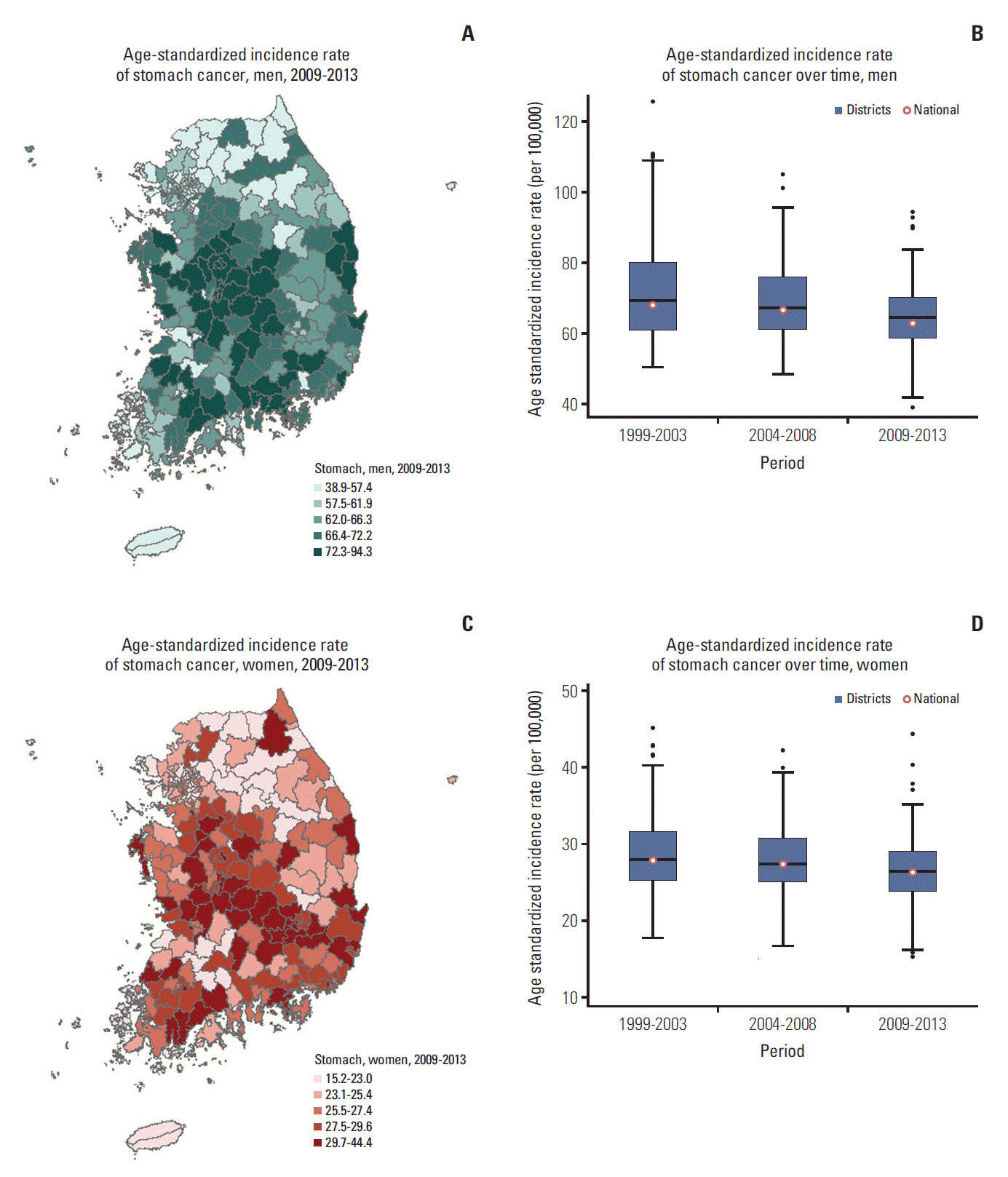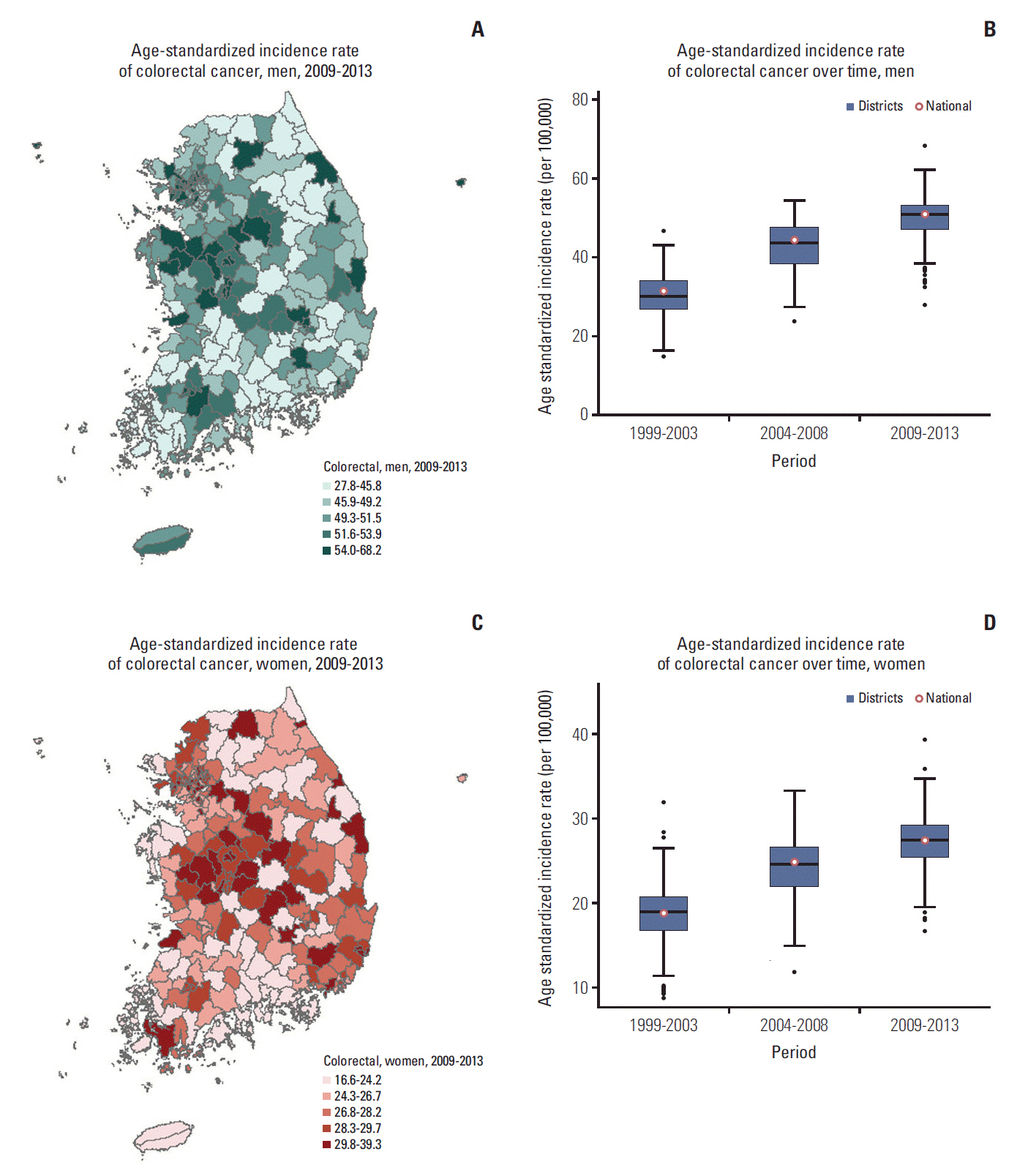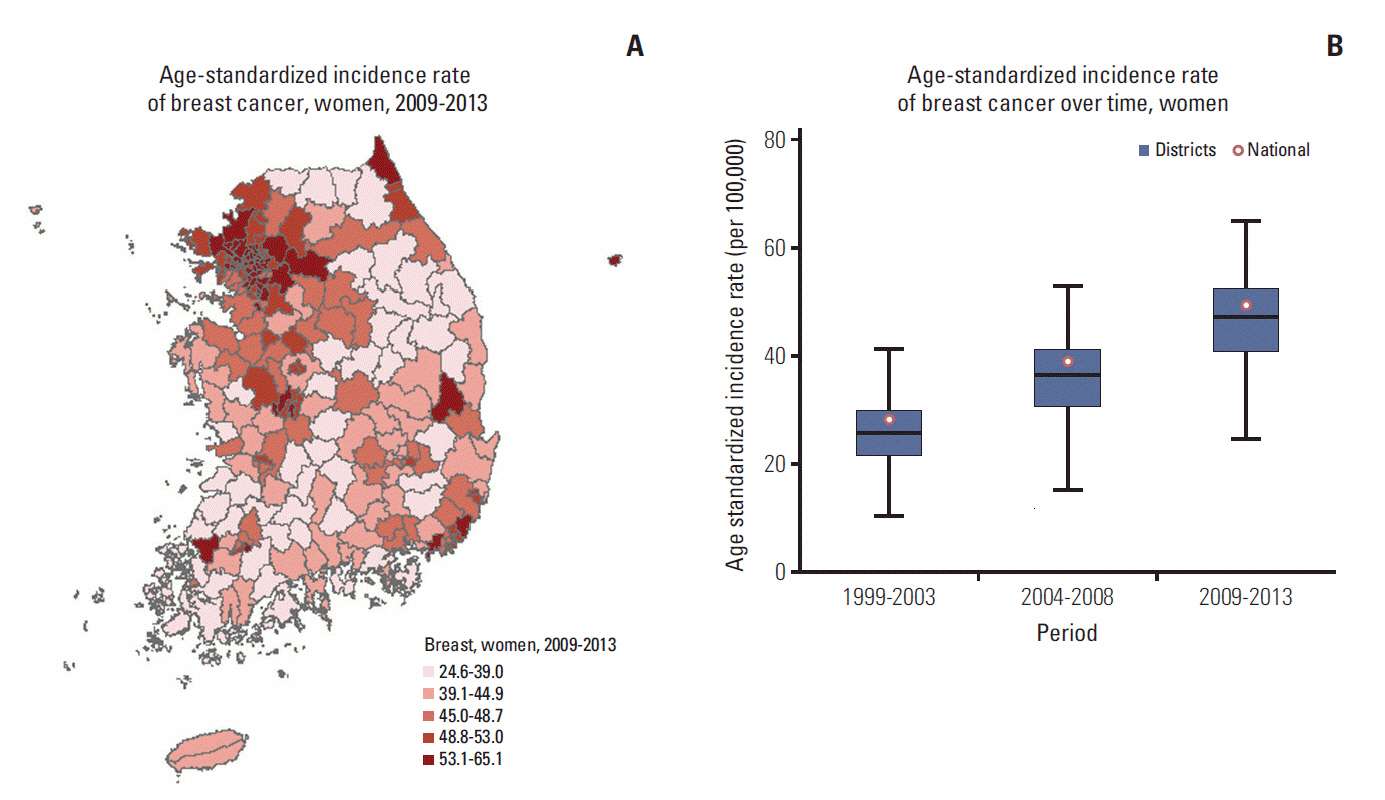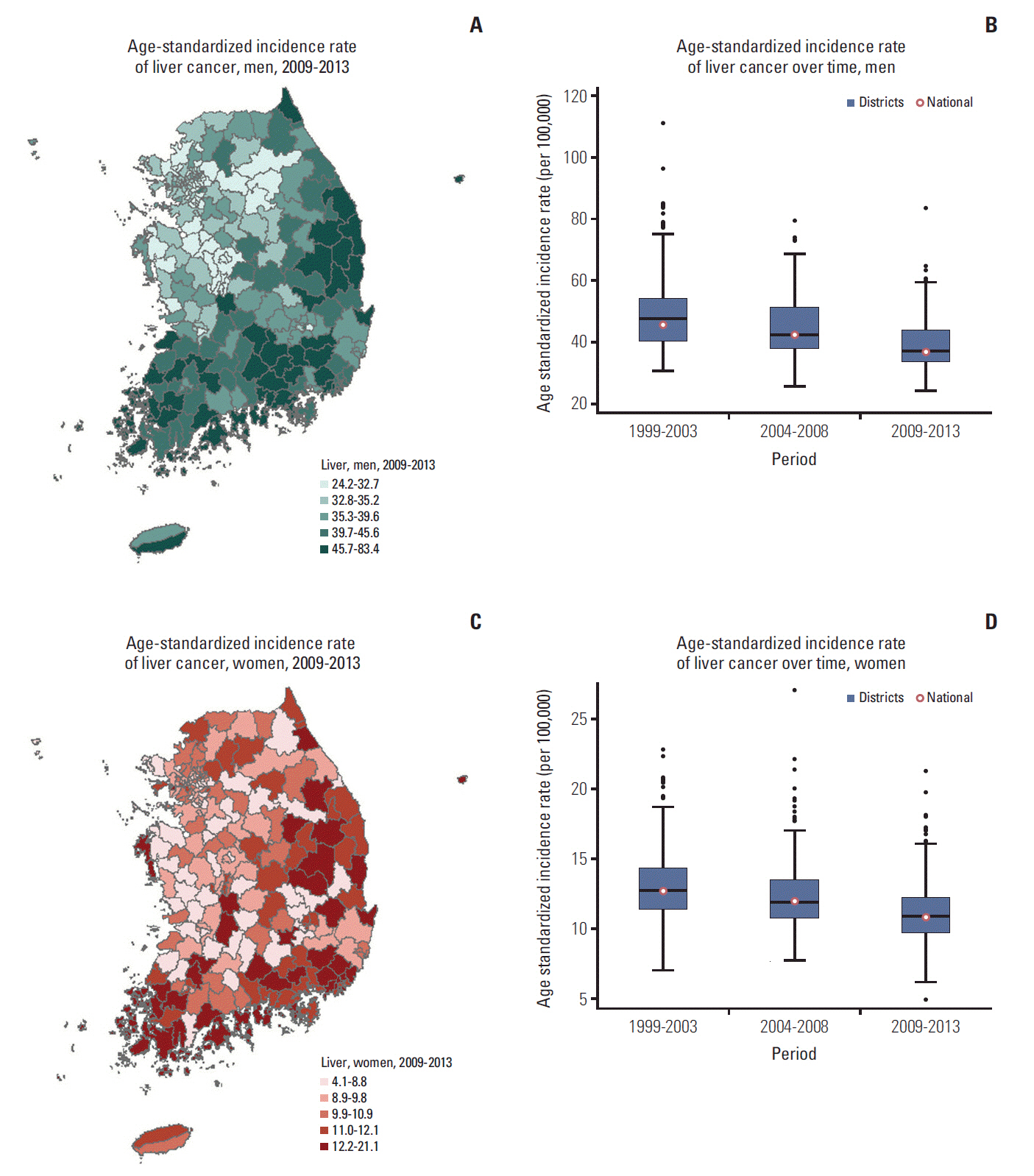Cancer Res Treat.
2018 Oct;50(4):1281-1293. 10.4143/crt.2017.411.
Geographical Variations and Trends in Major Cancer Incidences throughout Korea during 1999-2013
- Affiliations
-
- 1The Korea Central Cancer Registry, National Cancer Center, Goyang, Korea. ara@ncc.re.kr
- 2National Cancer Control Institute, National Cancer Center, Goyang, Korea.
- 3Department of Cancer Control and Population Health, National Cancer Center Graduate School of Cancer Science and Policy, National Cancer Center, Goyang, Korea.
- KMID: 2424800
- DOI: http://doi.org/10.4143/crt.2017.411
Abstract
- PURPOSE
We aimed to describe the temporal trends and district-level geographical variations in cancer incidences throughout Korea during 1999-2013.
MATERIALS AND METHODS
Data were obtained from the Korean National Cancer Incidence Database. We calculated the age-standardized cumulative cancer incidences according to sex and geographical region (metropolitan cities, provinces, and districts) for three 5-year periods (1999-2003, 2004-2008, and 2009-2013). Each quintile interval contained the same number of regions. Disease maps were created to visualize regional differences in the cancer incidences.
RESULTS
Substantial differences in cancer incidences were observed according to district and cancer type. The largest variations between geographical regions were found for thyroid cancer among both men and women. There was little variation in the incidences of stomach, colorectal, and lung cancer according to geographical region. Substantially elevated incidences of specific cancers were observed in Jeollanam-do (thyroid); Daejeon (colorectum); Jeollanam-do, Gyeongsangbuk-do, and Chungcheongbuk-do (lung); Seocho-gu, Gangnam-gu and Seongnam, Bundang-gu (breast and prostate); Chungcheong and Gyeongsang provinces (stomach); Ulleung-gun and the southern districts of Gyeongsangnam-do and Jeollanam-do (liver); and along the Nakdonggang River (gallbladder and biliary tract).
CONCLUSION
Mapping regional cancer incidences in Korea allowed us to compare the results according to geographical region. Our results may facilitate the development of infrastructure for systematic cancer incidence monitoring, which could promote the planning and implementation of region-specific cancer management programs.
Keyword
MeSH Terms
Figure
Cited by 1 articles
-
Descriptive Analysis of Gastric Cancer Mortality in Korea, 2000–2020
Tung Hoang, Hyeongtaek Woo, Sooyoung Cho, Jeeyoo Lee, Sayada Zartasha Kazmi, Aesun Shin
Cancer Res Treat. 2023;55(2):603-617. doi: 10.4143/crt.2022.307.
Reference
-
References
1. International Agency for Research on Cancer. GLOBOCAN 2012: estimated cancer incidence, mortality and prevalence worldwide in 2012 [Internet]. Lyon: International Agency for Research on Cancer;2012. [cited 2017 Aug 17]. Available from: http://publications.iarc.fr/Databases/Iarc-Cancerbases/Globocan-2012-Estimated-Cancer-Incidence-Mortality-And-Prevalence-Worldwide-In-2012-V1-0-2012.2. Torre LA, Bray F, Siegel RL, Ferlay J, Lortet-Tieulent J, Jemal A. Global cancer statistics, 2012. CA Cancer J Clin. 2015; 65:87–108.
Article3. U.S. Cancer Statistics Working Group. United States cancer statistics: 1999-2014 incidence and mortality web-based report [Internet]. Atlanta, GA: Department of Health and Human Services, Centers for Disease Control and Prevention and National Cancer Institute;2017. [cited 2017 Aug 17]. Available from: http://www.cdc.gov/uscs.4. Quinn M, Wood H, Cooper N, Rowan S. Cancer atlas of the United Kingdom and Ireland 1991-2000. New York: Palgrave Macmillan;2005.5. Cramb S, Mengersen K, Baade P. Atlas of cancer in Queensland: geographical variations in incidence and survival 1998-2007. Fortitude Valley: Viertel Centre for Research in Cancer Control, Cancer Council Queensland;2011.6. Shin HR, Won YJ, Jung KW, Kong HJ, Yim SH, Lee JK, et al. Nationwide cancer incidence in Korea, 1999~2001: first result using the national cancer incidence database. Cancer Res Treat. 2005; 37:325–31.
Article7. Statistics Korea [Internet]. Daejeon: Statistics Korea;2017. [cited 2017 Aug 17]. Available from: http://kosis.kr.8. Park S, Jee SH, Shin HR, Park EH, Shin A, Jung KW, et al. Attributable fraction of tobacco smoking on cancer using population-based nationwide cancer incidence and mortality data in Korea. BMC Cancer. 2014; 14:406.
Article9. Park S, Shin HR, Lee B, Shin A, Jung KW, Lee DH, et al. Attributable fraction of alcohol consumption on cancer using population-based nationwide cancer incidence and mortality data in the Republic of Korea. BMC Cancer. 2014; 14:420.
Article10. Korea Centers for Disease Control and Prevention; Ministry of Health and Welfare. 2011 Korea Community Health Survey [Internet]. Cheongju: Korea Centers for Disease Control and Prevention;2012. [cited 2017 Aug 17]. Available from: https://chs.cdc.go.kr/chs/.11. Lee BS, Cho YK, Jeong SH, Lee JH, Lee D, Park NH, et al. Nationwide seroepidemiology of hepatitis B virus infection in South Korea in 2009 emphasizes the coexistence of HBsAg and anti-HBs. J Med Virol. 2013; 85:1327–33.
Article12. Kwon GY, Lee H, Gwack J, Lee SW, Ki M, Youn SK. Regional distribution of hepatitis C virus infection in the Republic of Korea, 2007-2011. Gut Liver. 2014; 8:428–32.
Article13. Jeong YI, Shin HE, Lee SE, Cheun HI, Ju JW, Kim JY, et al. Prevalence of Clonorchis sinensis infection among residents along 5 Major Rivers in the Republic of Korea. Korean J Parasitol. 2016; 54:215–9.14. Brito JP, Kim HJ, Han SJ, Lee YS, Ahn HS. Geographic distribution and evolution of thyroid cancer epidemic in South Korea. Thyroid. 2016; 26:864–5.
Article15. Lee M, Park EC, Chang HS, Kwon JA, Yoo KB, Kim TH. Socioeconomic disparity in cervical cancer screening among Korean women: 1998-2010. BMC Public Health. 2013; 13:553.
Article16. Faggiano F, Partanen T, Kogevinas M, Boffetta P. Socioeconomic differences in cancer incidence and mortality. IARC Sci Publ. 1997; 138:65–176.17. Hiscock R, Bauld L, Amos A, Fidler JA, Munafo M. Socioeconomic status and smoking: a review. Ann N Y Acad Sci. 2012; 1248:107–23.
Article18. van Oers JA, Bongers IM, van de Goor LA, Garretsen HF. Alcohol consumption, alcohol-related problems, problem drinking, and socioeconomic status. Alcohol Alcohol. 1999; 34:78–88.
Article19. Lindstrom M, Hanson BS, Ostergren PO. Socioeconomic differences in leisure-time physical activity: the role of social participation and social capital in shaping health related behaviour. Soc Sci Med. 2001; 52:441–51.20. Robert SA, Strombom I, Trentham-Dietz A, Hampton JM, McElroy JA, Newcomb PA, et al. Socioeconomic risk factors for breast cancer: distinguishing individual- and community-level effects. Epidemiology. 2004; 15:442–50.
- Full Text Links
- Actions
-
Cited
- CITED
-
- Close
- Share
- Similar articles
-
- Epidemiology of Gastric Cancer in Korea: Trends in Incidence and Survival Based on Korea Central Cancer Registry Data (1999–2019)
- Trends in Head and Neck Cancer in South Korea Between 1999 and 2012
- Geographical distribution of health indicators related to snake bites and envenomation in Morocco between 1999 and 2013
- Trends of liver cancer and its major risk factors in Korea
- Association of Dietary Vitamin D and Calcium With Genetic Polymorphisms in Colorectal Neoplasia

